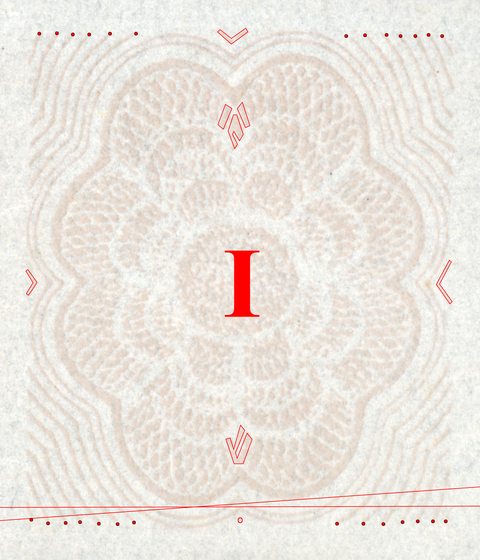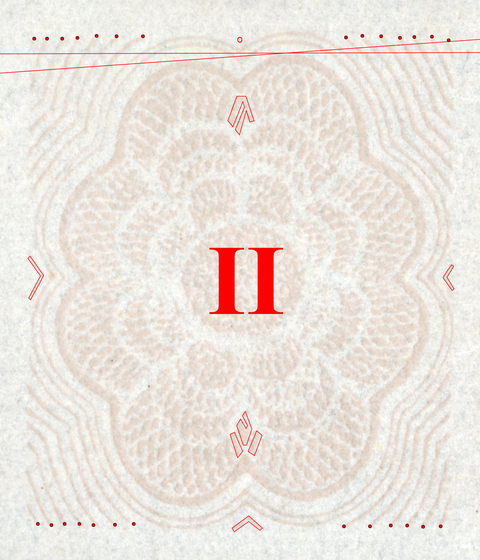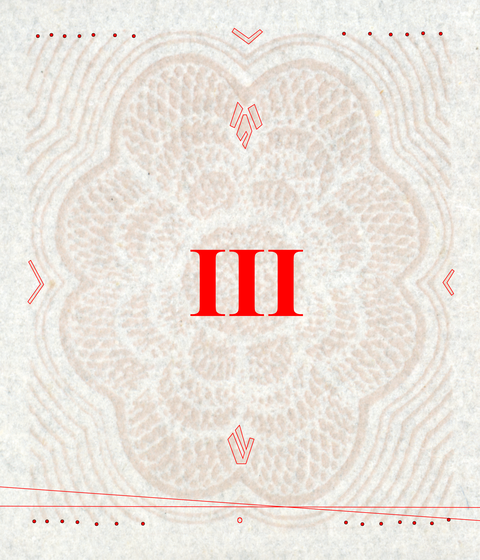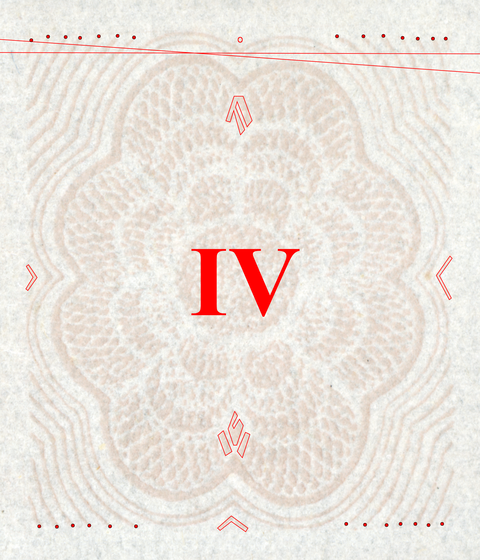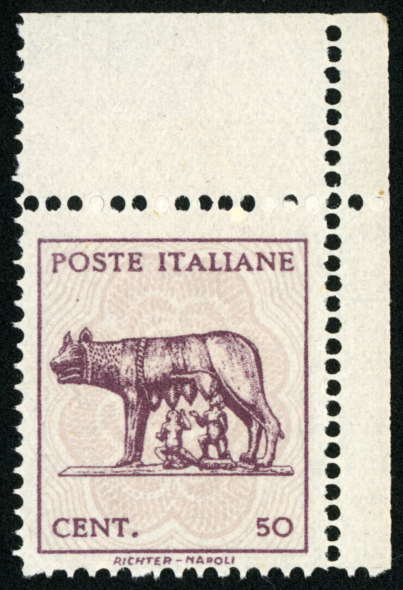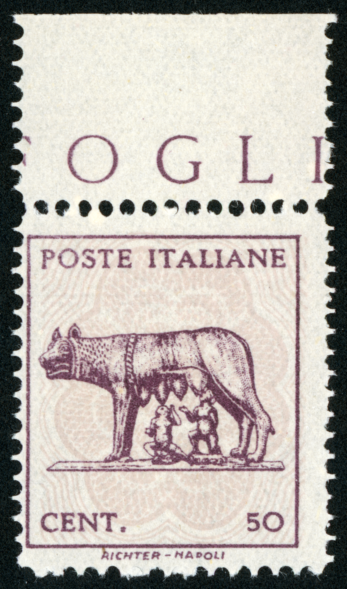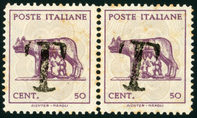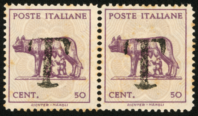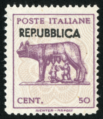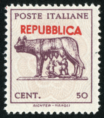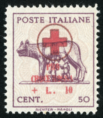Bari Wolf Notes
| Author: | Mitch Richling |
| Updated: | 2023-10-11 |
Copyright 2023 Mitch Richling. All rights reserved.
Table of Contents
1. Introduction
This document contains my notes on the Bari Wolf issue. The existing literature is hard to find and sometimes conflicting. So I have collected in these notes little scraps of information as I encounter them. Please keep in mind that I am not an expert in this issue, and it is quite likely these notes contain mistakes. To compound matters I'm sure I also introduced a great many errors as I transcribed my hand written journal entries into electronic form. I'm publishing what I have in hope that someone may find it useful.
2. Some History
After Italy was liberated near the end of world war two, Marshall Badoglio was installed as head of the provisional government. It must be understood that the provisional government was sanctioned by, and directed by, the occupying Allied Military Government.
In need of postage stamps, Marshall Badoglio submitted essays to the AMG for approval. The foreground image on the stamp was Badoglio's signature extending from the lower left corner to the upper right corner was in the foreground. Other than the signature being used instead of the Capitoline she-wolf, the designs were identical. The AMG vetoed this design feeling it was inappropriate for a nation newly freed from a dictatorship. So after, the so called "AMG Bari Wolf" issue was authorized by the ministerial ordinance of January 6, 1944. A rough translation follows:
MINISTERIAL DECREE 6 January 1914.
Issue of an ordinary 50 cent stamp.
Published in the Official Gazette of 15 January 1945, n. 2
THE UNDERSECRETARY OF STATE FOR POST AND TELEGRAPHS
IN CONCERT WITH
THE UNDERSECRETARY OF STATE FOR FINANCEHaving regard to article 21 of the Postal and Telecommunications Code, consolidated text approved with Royal decree February 27, 1936, n. 615;
Given the art. 239 of the implementing regulation of titles I and II of book I of said Postal and Telecommunications Code, approved by Royal Decree of 18 April 1940. u. GS9;
Having regard to the Royal Decree-Law of 10 November 1943, n. 5/B; Considering the need to issue a new ordinary postage stamp to be used for the payment of postal duties;
Declare:
Art. 1.
The issue of an ordinary 50 cents postage stamp is authorised, to be used for the payment of postal taxes.
Art. 2.
The stamp is of the rectangular paper format of 27x30mm and the print format of 23x26mm, printed by lithograph on white paper with or without watermark and without gumming.
The notching has 15 notches on the upper and lower sides and 18 lateral notches, at a distance of 1mm from each other.
In the center of the stamp there is an ornamental motif with eight curved sides within which, in the same darker colour, the Capitoline she-wolf is reproduced:
On the four sides; between the ornamental motif and the corners, within the printed format, run eight curved lines, which follow the design of the aforementioned ornamental motif.
The legend "Poste Italiane" is printed at the top and at the bottom, on the left, the word "Cent" and on the right, the citra "50".
At the bottom between the printed format and the indented margin is the wording "RICHTER - NAPLES". The stamp is printed in violet colour.
This decree will be published in the Official Gazette of the Kingdom special series.
From P. M. 151, this day January 6, 1944
FANO JUNG
The Government Printing Office in Rome was still in the hands of Germany in early 1944. In fact, Richter was one of the only printing shops that could be brought to production in time to produce the required stamps.
This issue was rushed to service very quickly under very difficult wartime conditions. It seems clear that the printer was given instructions to produce as many stamps as possible as quickly as possible. I think we see that in the way the burelage was haphazardly placed on the sheets. We also see it in the way the sheets were formatted to maximize the number of printed stamps. More dramatically we see this in the great variety of printing oddities found in this issue. It is unclear to me if these oddities are a result of printer's waste making it into the hands of collectors, or a result of the printer simply accepting some anomalies for higher production output. I suspect it may be a bit of both.
The stamps were issued first in the city of Bari, and were pushed to other locations later.
3. Plates & Papers
The printing plates and sheets come in two geometries.
I have seen conflicting remarks on which of the sheet formats were printed first, but I think the consensus is that the first run was printed on watermarked paper with 150 subjects (10 across and 15 vertically). These appeared in January 1944. The second run was printed on unwatermarked paper with 168 subjects (12 horizontal by 14 vertically). These appeared later that year in perhaps April or May.
150 subjects printed 10 across and 15 down. These sheets are watermarked. The sheets are about 486mm tall by 289mm wide give or take a couple millimeters as I measured it with a yard stick.
| 150 | 01 | 02 | 03 | 04 | 05 | 06 | 07 | 08 | 09 | 10 |
| 01 | 1 | 2 | 3 | 4 | 5 | 6 | 7 | 8 | 9 | 10 |
| 02 | 11 | 12 | 13 | 14 | 15 | 16 | 17 | 18 | 19 | 20 |
| 03 | 21 | 22 | 23 | 24 | 25 | 26 | 27 | 28 | 29 | 30 |
| 04 | 31 | 32 | 33 | 34 | 35 | 36 | 37 | 38 | 39 | 40 |
| 05 | 41 | 42 | 43 | 44 | 45 | 46 | 47 | 48 | 49 | 50 |
| 06 | 51 | 52 | 53 | 54 | 55 | 56 | 57 | 58 | 59 | 60 |
| 07 | 61 | 62 | 63 | 64 | 65 | 66 | 67 | 68 | 69 | 70 |
| 08 | 71 | 72 | 73 | 74 | 75 | 76 | 77 | 78 | 79 | 80 |
| 09 | 81 | 82 | 83 | 84 | 85 | 86 | 87 | 88 | 89 | 90 |
| 10 | 91 | 92 | 93 | 94 | 95 | 96 | 97 | 98 | 99 | 100 |
| 11 | 101 | 102 | 103 | 104 | 105 | 106 | 107 | 108 | 109 | 110 |
| 12 | 111 | 112 | 113 | 114 | 115 | 116 | 117 | 118 | 119 | 120 |
| 13 | 121 | 122 | 123 | 124 | 125 | 126 | 127 | 128 | 129 | 130 |
| 14 | 131 | 132 | 133 | 134 | 135 | 136 | 137 | 138 | 139 | 140 |
| 15 | 141 | 142 | 143 | 144 | 145 | 146 | 147 | 148 | 149 | 150 |
The selvage is mostly empty except for a cross printed on the bottom selvage at the center of the sheet – the vertical part of the cross frequently appearing on, or near, the perforations separating the 5th and 6th columns of stamps.
168 subjects printed 12 across and 14 down. These sheets were unwatermarked. The sheets are about 453mm tall by 342mm wide give or take a couple millimeters as I measured it with a yard stick.
| 1 | 2 | 3 | 4 | 5 | 6 | 7 | 8 | 9 | 10 | 11 | 12 | 01 |
| 13 | 14 | 15 | 16 | 17 | 18 | 19 | 20 | 21 | 22 | 23 | 24 | 02 |
| 25 | 26 | 27 | 28 | 29 | 30 | 31 | 32 | 33 | 34 | 35 | 36 | 03 |
| 37 | 38 | 39 | 40 | 41 | 42 | 43 | 44 | 45 | 46 | 47 | 48 | 04 |
| 49 | 50 | 51 | 52 | 53 | 54 | 55 | 56 | 57 | 58 | 59 | 60 | 05 |
| 61 | 62 | 63 | 64 | 65 | 66 | 67 | 68 | 69 | 70 | 71 | 72 | 06 |
| 73 | 74 | 75 | 76 | 77 | 78 | 79 | 80 | 81 | 82 | 83 | 84 | 07 |
| 85 | 86 | 87 | 88 | 89 | 90 | 91 | 92 | 93 | 94 | 95 | 96 | 08 |
| 97 | 98 | 99 | 100 | 101 | 102 | 103 | 104 | 105 | 106 | 107 | 108 | 09 |
| 109 | 110 | 111 | 112 | 113 | 114 | 115 | 116 | 117 | 118 | 119 | 120 | 10 |
| 121 | 122 | 123 | 124 | 125 | 126 | 127 | 128 | 129 | 130 | 131 | 132 | 11 |
| 133 | 134 | 135 | 136 | 137 | 138 | 139 | 140 | 141 | 142 | 143 | 144 | 12 |
| 145 | 146 | 147 | 148 | 149 | 150 | 151 | 152 | 153 | 154 | 155 | 156 | 13 |
| 157 | 158 | 159 | 160 | 161 | 162 | 163 | 164 | 165 | 166 | 167 | 168 | 14 |
| 01 | 02 | 03 | 04 | 05 | 06 | 07 | 08 | 09 | 10 | 11 | 12 | 168 |
The lower part of the selvage is similar to the watermarked sheets; however, the top of the selvage has an elaborate imprint:
HWW says two plates were used for each paper type, and the plates can be differentiated by the selvage. Unfortunately I have been unable to obtain samples of all the plates, so I can't provide additional detail.
3.1. Measuring Paper Thickness
Paper thickness measurements are more complex than one might first guess. Paper thickness gauges, essentially micrometers specially designed for the task, produce much less pressure between the measuring surfaces than a standard micrometer. In general paper thickness measurements taken with a standard micrometer will be smaller than those taken with a paper thickness gauge because the standard micrometer will compress the paper more. Unfortunately there is no standard way to convert measurements between the two instruments as the delta is determined by the bulk compressibility of the paper being measured. Paper thickness measurements in the philatelic literature are generally made with a mixture of the two devices; however, few authors document which device they used! Even fewer authors document the methodology of how the measurements were collected.
For my Bari Wolf collection I use a standard micrometer for paper thickness measurements. For each stamp I take 5 measurements across the surface of the stamp in the order and locations indicated below:
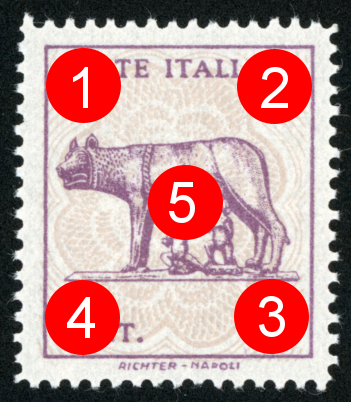
I then report the thickness in microns as the mean (average) plus or minus the sample standard deviation like this: \(76.1\pm 1.90\,\mathrm{microns}\)
Unless otherwise indicated, thickness measurements are of ungummed paper.
4. Burelage Types
4.2. Locations on Plates
Burelage types on both the 150 (in cyan & green) and the 168 (in yellow & green) subject plates.
| 150 | 1 | 2 | 3 | 4 | 5 | 6 | 7 | 8 | 9 | 10 | |||
| 1 | II |
IV |
IV |
IV |
I |
I |
IV |
I |
II |
III |
|||
| 2 | I |
IV |
IV |
II |
I |
I |
II |
IV |
III |
II |
II |
IV |
1 |
| 3 | III |
I |
I |
IV |
III |
I |
I |
IV |
III |
I |
III |
IV |
2 |
| 4 | III |
II |
III |
IV |
II |
II |
I |
IV |
I |
IV |
IV |
III |
3 |
| 5 | IV |
IV |
I |
I |
I |
II |
IV |
III |
II |
I |
II |
IV |
4 |
| 6 | I |
I |
I |
I |
II |
I |
I |
I |
II |
II |
I |
III |
5 |
| 7 | II |
I |
I |
IV |
II |
IV |
IV |
I |
I |
I |
IV |
IV |
6 |
| 8 | III |
I |
III |
III |
II |
IV |
I |
IV |
I |
III |
II |
IV |
7 |
| 9 | III |
I |
II |
IV |
I |
I |
III |
III |
IV |
IV |
I |
I |
8 |
| 10 | I |
II |
III |
III |
IV |
II |
IV |
I |
II |
III |
IV |
III |
9 |
| 11 | III |
I |
II |
III |
II |
III |
I |
I |
IV |
I |
IV |
III |
10 |
| 12 | III |
IV |
III |
II |
II |
III |
III |
III |
II |
II |
IV |
II |
11 |
| 13 | III |
III |
III |
II |
II |
IV |
III |
II |
II |
II |
II |
IV |
12 |
| 14 | IV |
IV |
III |
II |
I |
IV |
III |
IV |
IV |
II |
II |
IV |
13 |
| 15 | IV |
III |
III |
I |
III |
III |
IV |
IV |
IV |
III |
III |
IV |
14 |
| 1 | 2 | 3 | 4 | 5 | 6 | 7 | 8 | 9 | 10 | 11 | 12 | 168 |
4.3. Blocks of 4 with all four burelage types
Blocks of four with all four Burelage types are marked in pink & yellow (with pink indicating the upper left of each block of four).
| 150 | 1 | 2 | 3 | 4 | 5 | 6 | 7 | 8 | 9 | 10 | |||
| 1 | II |
IV |
IV |
IV |
I |
I |
IV |
I |
II |
III |
|||
| 2 | I |
IV |
IV |
II |
I |
I |
II |
IV |
III |
II |
II |
IV |
1 |
| 3 | III |
I |
I |
IV |
III |
I |
I |
IV |
III |
I |
III |
IV |
2 |
| 4 | III |
II |
III |
IV |
II |
II |
I |
IV |
I |
IV |
IV |
III |
3 |
| 5 | IV |
IV |
I |
I |
I |
II |
IV |
III |
II |
I |
II |
IV |
4 |
| 6 | I |
I |
I |
I |
II |
I |
I |
I |
II |
II |
I |
III |
5 |
| 7 | II |
I |
I |
IV |
II |
IV |
IV |
I |
I |
I |
IV |
IV |
6 |
| 8 | III |
I |
III |
III |
II |
IV |
I |
IV |
I |
III |
II |
IV |
7 |
| 9 | III |
I |
II |
IV |
I |
I |
III |
III |
IV |
IV |
I |
I |
8 |
| 10 | I |
II |
III |
III |
IV |
II |
IV |
I |
II |
III |
IV |
III |
9 |
| 11 | III |
I |
II |
III |
II |
III |
I |
I |
IV |
I |
IV |
III |
10 |
| 12 | III |
IV |
III |
II |
II |
III |
III |
III |
II |
II |
IV |
II |
11 |
| 13 | III |
III |
III |
II |
II |
IV |
III |
II |
II |
II |
II |
IV |
12 |
| 14 | IV |
IV |
III |
II |
I |
IV |
III |
IV |
IV |
II |
II |
IV |
13 |
| 15 | IV |
III |
III |
I |
III |
III |
IV |
IV |
IV |
III |
III |
IV |
14 |
| 1 | 2 | 3 | 4 | 5 | 6 | 7 | 8 | 9 | 10 | 11 | 12 | 168 |
Blocks of four with all four Burelage types are frequently collected. Bush made pages for them. With 11 blocks on the 150 sheets and 13 on the 168 sheets, plenty examples exist. Finding a block on cover is quite rare – I have seen four, and two were fakes. None of the blocks are in numerical order in reading direction – left to right & top to bottom; however, some are in order as one moves clockwise or counter clockwise around the block. Such blocks with the type I being at the upper left are more valuable.
| 150 | 168 | Types | |||||||||
|---|---|---|---|---|---|---|---|---|---|---|---|
| \(P_{LU}\) | \(P_{RU}\) | \(P_{LL}\) | \(P_{RL}\) | \(P_{LU}\) | \(P_{RU}\) | \(P_{LL}\) | \(P_{RL}\) | LU | RU | LL | RL |
| 8 | 9 | 18 | 19 | - | - | - | - | I | II | IV | III |
| 14 | 15 | 24 | 25 | 4 | 5 | 16 | 17 | II | I | IV | III |
| 32 | 33 | 42 | 43 | 26 | 27 | 38 | 39 | II | III | IV | I |
| 38 | 39 | 48 | 49 | 32 | 33 | 44 | 45 | IV | I | III | II |
| - | - | - | - | 47 | 48 | 59 | 60 | II | IV | I | III |
| - | - | - | - | 70 | 71 | 82 | 83 | I | IV | III | II |
| 74 | 75 | 84 | 85 | 76 | 77 | 88 | 89 | III | II | IV | I |
| - | - | - | - | 82 | 83 | 94 | 95 | III | II | IV | I |
| 86 | 87 | 96 | 97 | 90 | 91 | 102 | 103 | I | III | II | IV |
| 88 | 89 | 98 | 99 | 92 | 93 | 104 | 105 | III | IV | I | II |
| 96 | 97 | 106 | 107 | 102 | 103 | 114 | 115 | II | IV | III | I |
| 99 | 100 | 109 | 110 | 105 | 106 | 117 | 118 | II | III | IV | I |
| 102 | 103 | 112 | 113 | 110 | 111 | 122 | 123 | I | II | IV | III |
| 108 | 109 | 118 | 119 | 116 | 117 | 128 | 129 | I | IV | III | II |
4.4. Horizontal strips of four with all four burelage types
Horizontal strips of four with all four Burelage types are marked in pink & yellow (with pink indicating the left of each strip of four).
| 150 | 1 | 2 | 3 | 4 | 5 | 6 | 7 | 8 | 9 | 10 | |||
| 1 | II |
IV |
IV |
IV |
I |
I |
IV |
I |
II |
III |
|||
| 2 | I |
IV |
IV |
II |
I |
I |
II |
IV |
III |
II |
II |
IV |
1 |
| 3 | III |
I |
I |
IV |
III |
I |
I |
IV |
III |
I |
III |
IV |
2 |
| 4 | III |
II |
III |
IV |
II |
II |
I |
IV |
I |
IV |
IV |
III |
3 |
| 5 | IV |
IV |
I |
I |
I |
II |
IV |
III |
II |
I |
II |
IV |
4 |
| 6 | I |
I |
I |
I |
II |
I |
I |
I |
II |
II |
I |
III |
5 |
| 7 | II |
I |
I |
IV |
II |
IV |
IV |
I |
I |
I |
IV |
IV |
6 |
| 8 | III |
I |
III |
III |
II |
IV |
I |
IV |
I |
III |
II |
IV |
7 |
| 9 | III |
I |
II |
IV |
I |
I |
III |
III |
IV |
IV |
I |
I |
8 |
| 10 | I |
II |
III |
III |
IV |
II |
IV |
I |
II |
III |
IV |
III |
9 |
| 11 | III |
I |
II |
III |
II |
III |
I |
I |
IV |
I |
IV |
III |
10 |
| 12 | III |
IV |
III |
II |
II |
III |
III |
III |
II |
II |
IV |
II |
11 |
| 13 | III |
III |
III |
II |
II |
IV |
III |
II |
II |
II |
II |
IV |
12 |
| 14 | IV |
IV |
III |
II |
I |
IV |
III |
IV |
IV |
II |
II |
IV |
13 |
| 15 | IV |
III |
III |
I |
III |
III |
IV |
IV |
IV |
III |
III |
IV |
14 |
| 1 | 2 | 3 | 4 | 5 | 6 | 7 | 8 | 9 | 10 | 11 | 12 | 168 |
Strips of four with all four burelage types are not as commonly collected. I know of no commercially available album pages. They are also a bit rarer with only 10 on the 150 sheets and 12 on the 168 sheets. It is very uncommon to see them on the market. Two are in numerical order – one from right to left and one from left to right.
| 150 | 168 | Types | |||||||||
|---|---|---|---|---|---|---|---|---|---|---|---|
| \(P_{LU}\) | \(P_{RU}\) | \(P_{LL}\) | \(P_{RL}\) | \(P_{LU}\) | \(P_{RU}\) | \(P_{LL}\) | \(P_{RL}\) | LU | RU | LL | RL |
| 7 | 8 | 9 | 10 | - | - | - | - | IV | I | II | III |
| 16 | 17 | 18 | 19 | 6 | 7 | 8 | 9 | I | II | IV | III |
| 45 | 46 | 47 | 48 | 41 | 42 | 43 | 44 | I | II | IV | III |
| 47 | 48 | 49 | 50 | 43 | 44 | 45 | 46 | IV | III | II | I |
| 74 | 75 | 76 | 77 | 76 | 77 | 78 | 79 | III | II | IV | I |
| - | - | - | - | 80 | 81 | 82 | 83 | IV | I | III | II |
| - | - | - | - | 81 | 82 | 83 | 84 | I | III | II | IV |
| 81 | 82 | 83 | 84 | 85 | 86 | 87 | 88 | III | I | II | IV |
| 97 | 98 | 99 | 100 | 103 | 104 | 105 | 106 | IV | I | II | III |
| - | - | - | - | 104 | 105 | 106 | 107 | I | II | III | IV |
| 132 | 133 | 134 | 135 | 146 | 147 | 148 | 149 | IV | III | II | I |
| 133 | 134 | 135 | 136 | 147 | 148 | 149 | 150 | III | II | I | IV |
| 134 | 135 | 136 | 137 | 148 | 149 | 150 | 151 | II | I | IV | III |
4.5. Vertical strips of four with all four burelage types
Vertical strips of four with all four Burelage types are marked in pink & yellow (with pink indicating the top of each strip of four).
| 150 | 1 | 2 | 3 | 4 | 5 | 6 | 7 | 8 | 9 | 10 | |||
| 1 | II |
IV |
IV |
IV |
I |
I |
IV |
I |
II |
III |
|||
| 2 | I |
IV |
IV |
II |
I |
I |
II |
IV |
III |
II |
II |
IV |
1 |
| 3 | III |
I |
I |
IV |
III |
I |
I |
IV |
III |
I |
III |
IV |
2 |
| 4 | III |
II |
III |
IV |
II |
II |
I |
IV |
I |
IV |
IV |
III |
3 |
| 5 | IV |
IV |
I |
I |
I |
II |
IV |
III |
II |
I |
II |
IV |
4 |
| 6 | I |
I |
I |
I |
II |
I |
I |
I |
II |
II |
I |
III |
5 |
| 7 | II |
I |
I |
IV |
II |
IV |
IV |
I |
I |
I |
IV |
IV |
6 |
| 8 | III |
I |
III |
III |
II |
IV |
I |
IV |
I |
III |
II |
IV |
7 |
| 9 | III |
I |
II |
IV |
I |
I |
III |
III |
IV |
IV |
I |
I |
8 |
| 10 | I |
II |
III |
III |
IV |
II |
IV |
I |
II |
III |
IV |
III |
9 |
| 11 | III |
I |
II |
III |
II |
III |
I |
I |
IV |
I |
IV |
III |
10 |
| 12 | III |
IV |
III |
II |
II |
III |
III |
III |
II |
II |
IV |
II |
11 |
| 13 | III |
III |
III |
II |
II |
IV |
III |
II |
II |
II |
II |
IV |
12 |
| 14 | IV |
IV |
III |
II |
I |
IV |
III |
IV |
IV |
II |
II |
IV |
13 |
| 15 | IV |
III |
III |
I |
III |
III |
IV |
IV |
IV |
III |
III |
IV |
14 |
| 1 | 2 | 3 | 4 | 5 | 6 | 7 | 8 | 9 | 10 | 11 | 12 | 168 |
These are even less commonly collected than then horizontal strips, and are quite rare. Both the 150 subject sheets and the 168 subject sheets have 9 examples per sheet.
| 150 | 168 | Types | |||||||||
|---|---|---|---|---|---|---|---|---|---|---|---|
| \(P_{LU}\) | \(P_{RU}\) | \(P_{LL}\) | \(P_{RL}\) | \(P_{LU}\) | \(P_{RU}\) | \(P_{LL}\) | \(P_{RL}\) | LU | RU | LL | RL |
| 10 | 20 | 30 | 40 | - | - | - | - | III | II | I | IV |
| - | - | - | - | 23 | 35 | 47 | 59 | III | IV | II | I |
| 31 | 41 | 51 | 61 | 25 | 37 | 49 | 61 | III | IV | I | II |
| 41 | 51 | 61 | 71 | 37 | 49 | 61 | 73 | IV | I | II | III |
| 60 | 70 | 80 | 90 | 58 | 70 | 82 | 94 | II | I | III | IV |
| 76 | 86 | 96 | 106 | 78 | 90 | 102 | 114 | IV | I | II | III |
| 90 | 100 | 110 | 120 | 94 | 106 | 118 | 130 | IV | III | I | II |
| 92 | 102 | 112 | 122 | 98 | 110 | 122 | 134 | II | I | IV | III |
| 108 | 118 | 128 | 138 | 116 | 128 | 140 | 152 | I | III | II | IV |
5. Printing Varieties (elements present)
One of the ways in which this issue is unique is the number of variations related to what design elements are printed on a stamp. The "normal" case is printing on one side of the stamp, and that side should have a wolf and the burelage. Sometimes things went wrong. For example the burelage might be missing, the wolf might be missing. Keeping track of these varieties is a challenge, and so I have developed a shorthand notation to describe the various situations that arise.
5.1. Code for elements present
;; eWeB ;; | | ;; | +- Background (Burelage) ;; +- Foreground (Wolf, Frame, etc...)
The e values may be one of:
n– Normal0– Missingi– Inverted (only used for Wolf and only for stamps printed on both sides)d– Double impressionz– Double impression with one inverted (only used for Wolf)h– Horizontal (i.e. rotated 90 degrees)N– Normal & badly shiftedI– Inverted & badly shifted (only used for Wolf)D– Double impression & badly shiftedZ– Double impression with one inverted & one or both badly shifted (only used for Wolf)
The "i" & "I" codes are only used for stamps printed on both sides. ;)
For stamps printed on both sides, we just concatenate the codes for each side like so:
;; eWeBeWeB ;; | | | | ;; | | | +- Back Background (Burelage) ;; | | +- Back Foreground (Wolf, Frame, etc...) ;; | +- Front Background (Burelage) ;; +- Front Foreground (Wolf, Frame, etc...)
Note the code for two sided stamps requires us to pick which side is the "front". I do so by considering the following rules using the first that fits:
The "Front" of the stamp is determined using the following rules in sequence:
- If only one side has a wolf, then the wolf side is the front
- If one side contains both wolf & burelage, and the other doesn't, then the side with both is the front
- The better centered side is the front
- More complete side is front (ex: missing frame line vs full frame)
- The side with the darker shade is the front
- Just pick one – the choice is arbitrary. ;)
With regard to the "i" code, we need to decide which way is "UP". If the front of the stamp has a wolf, then the stamp is oriented with the wolf standing up.
If no wolf appears on the front, then "up" is arbitrary.
5.2. Known types
| Front | Front | Back | Back | Examples in | |
|---|---|---|---|---|---|
| Code | Wolf | Burelage | Wolf | Burelage | my Collection |
nWnBiW0B |
Normal | Normal | Inverted | Missing | bwIDp2s016 bwIDp2s014 bwIDp2s013 bwIDp2s001 |
dW0BIWNB |
Double | Missing | Shifted & Inverted | Shifted Normal | bwIDp2s012 bwIDp2s002 |
nWnB0WnB |
Normal | Normal | Missing | Normal | bwIDp2s015 bwIDp2s003 |
nWdB0WnB |
Normal | Double | Missing | Normal | bwIDp2s007 |
nWnBNW0B |
Normal | Normal | Shifted Normal | Missing | bwIDp2s004 |
NWNBnW0B |
Shifted Normal | Shifted Normal | Normal | Missing | bwIDp2s008 |
nWnBnW0B |
Normal | Normal | Normal | Missing | bwIDp2s010 bwIDp2s009 bwIDp2s006 |
nW0BnW0B |
Normal | Missing | Normal | Missing | bwIDp2s011 bwIDp2s005 |
dW0BnW0B |
Double | Missing | Normal | Missing | |
dWdB0WnB |
Double | Double | Missing | Normal | bwIDp2s018 |
0WnB |
Missing | Normal | N/A | N/A | bwIDmisfg004 bwIDmisfg003 bwIDmisfg002 bwIDmisfg001 |
nW0B |
Normal | Missing | N/A | N/A | bwIDmisbg006 bwIDmisbg005 bwIDmisbg004 bwIDmisbg003 bwIDmisbg002 bwIDmisbg001 |
dWnB |
Double | Normal | N/A | N/A | bwIDdbl005 bwIDdbl004 bwIDdbl003 bwIDdbl002 bwIDdbl001 |
zWnB |
Inverted Double | Normal | N/A | N/A | bwIDidbl003 bwIDidbl002 bwIDidbl001 |
nWhB |
Normal | Horizontally | N/A | N/A | bwIDbh001 |
Some additional notes:
dW0BnW0B- I have seen one of these at auction, but I don't have an example.
nW0BnW0B- These exist in two forms:
- Completely normal wolf design on both sides
- One one side of the stamp the wolf design clipped at the left – i.e. it is as if the left side of the stamp simply wasn't printed. The left frame line is always missing on these clipped examples with the missing elements sometimes expending as far as the wolf's shoulder.
nWnB0WnB- Sometimes misidentified as
dWdB0WnB.
6. Color Varieties
I am aware of no scientific investigation of the inks used or colorimetric measurements for this issue. Various sources describe the colors using the terms listed below. It is pretty common to find bush pages printed with these labels, and that's a good way to map the descriptions to actual stamps.
Foreground colors:
- Pale Lilac
- Rose Lilac
- Dark (Black to very dark brown)
- Violet
- Dark lilac
- Light lilac
Background colors:
- Dark (Dark tan to greenish tan)
- Dark lilac
- Medium lilac
- Light lilac
WARNING: I make color measurements for stamps in my collection using my scanner. My scanner has been remarkably consistent over time, and has been invaluable in assisting in the comparison of colors across my collection. That said, my scanner is not color calibrated, and therefore the measurements are not necessarily directly useful for others.
7. Perforation Varieties
7.1. Literature overview
Early versions of BUSH listed the following three perforation combinations:
- \(11 \times 11\)
- \(11 \times 11\frac{1}{2}\)
- \(11\frac{1}{2} \times 11\frac{1}{2}\).
Later editions replaced the \(11\) values by \(10\frac{3}{4}\).
FM lists a far larger collection of perforation combinations:
- \(10\frac{3}{4}\) horizontally by \(10\frac{3}{4}\), \(11\), \(11\frac{1}{4}\), and \(11\frac{1}{2}\) vertically.
- \(11\) horizontally by \(11\), \(11\frac{1}{4}\), \(11\frac{1}{2}\) vertically.
- \(11\frac{1}{4}\) horizontally by \(11\frac{1}{4}\), and \(11\frac{1}{2}\).
- \(11\frac{1}{2} \times 11\frac{1}{2}\).
- \(14 \times 14\), \(14\frac{1}{2} \times 14\), \(14 \times 11\frac{1}{2}\) – all very rare.
FM also indicates that, while extremely rare, perforation "inversions" exist. For example \(11\frac{1}{2} \times 10\frac{3}{4}\) instead of \(10\frac{3}{4} \times 11\frac{1}{2}\).
The Scott catalog lists four combinations:
- \(10\frac{1}{2} \times 11\frac{1}{2}\)
- \(11 \times 11\frac{1}{2}\)
- \(11\frac{1}{2}\)
- \(14\)
7.2. My Collection
If my collection is representative, then we really have a couple of groupings – one near \(10\frac{7}{8}\) and another just below \(11\frac{1}{2}\). It is impossible to tell if the outliers are extremely rare perforation examples, or just due to odd paper deformations. It's interesting to note the measurements near \(10\frac{7}{8}\) in that about half fall to the left being rounded to \(10\frac{3}{4}\) and about half fall to the right being rounded to \(11\). This explains the confusion in the literature regarding \(10\frac{3}{4}\) vs \(11\). Once again, these observations are all invalid if my collection is not representative, and I have no way to really know if the 150 examples I have measured really are representative of the overall population.
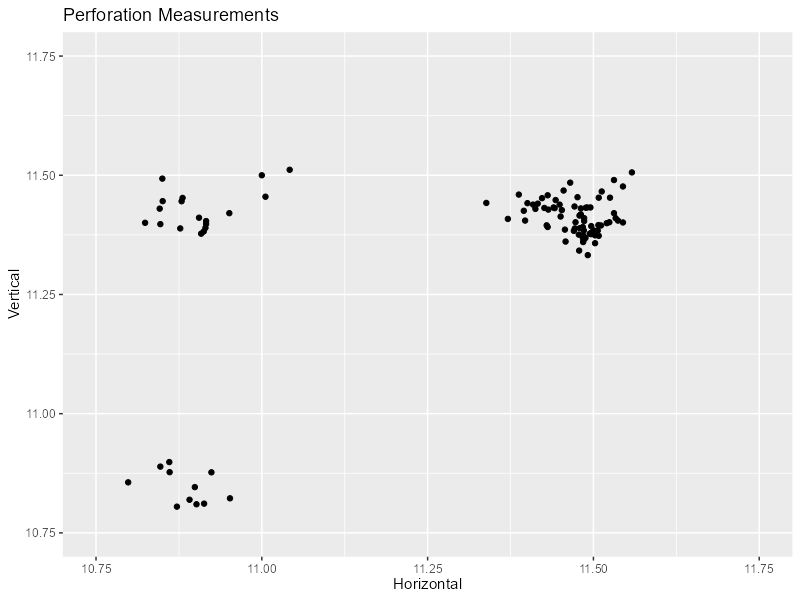
7.3. Imperforate variations
- No perforations one side (known for all four sides). Frequently collected as a horizontal/vertical pair missing perforations between, or as a margin piece with no perforations on the margin side.
- No perforations two sides (opposite sides are common, sides sharing a corner are less common). Frequently collected as horizontal/vertical pairs with perforations between and at the ends.
- No perforations three sides (known for all four sides). Frequently collected as a pair with only perforations between the stamps. The best examples are a strip of three with an imperf on one end and a fully perforated example at the other – leaving the middle with one perforated edge.
- Imperforate. Frequently collected as edge pieces or in multiples. The most desirable are blocks of 9 or blocks of 6 with attached selvage.
7.4. Rough Perforations
7.4.1. Incomplete perforation
Some examples will show clear perforation holes, but they are irregular with hanging chads. The most common cases are roughly \(11 \times 11 \frac{1}{2}\).
| Normal | Rough |
|---|---|
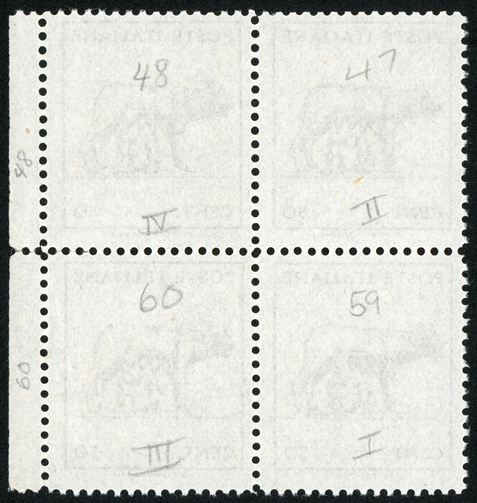 |
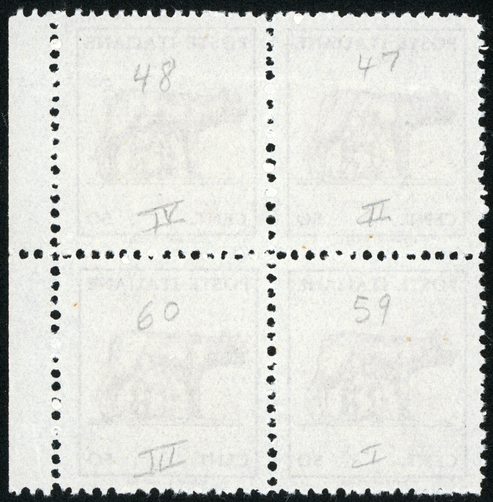 |
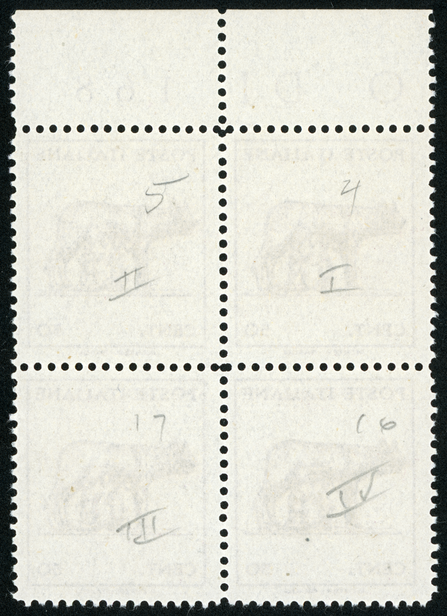 |
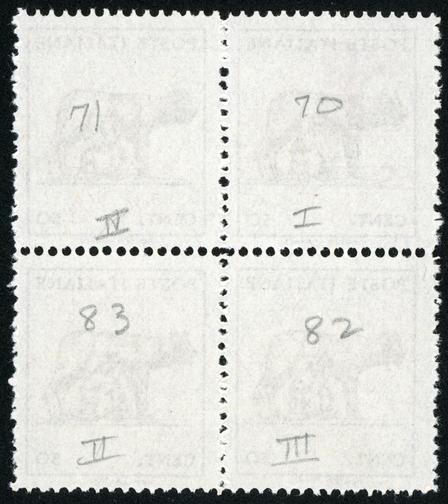 |
| Normal | Rough |
In some cases the perforation is so incomplete that the perforation edges appear to be little more than ragged, torn edges. Measuring the perforation gauge on some examples is almost impossible. Consider the bottom edge of the following stamp:
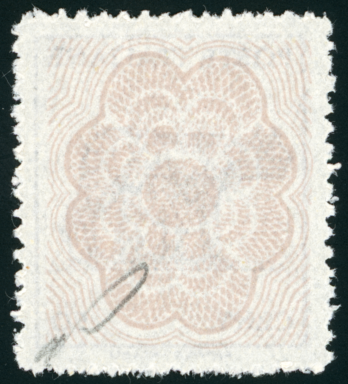 |
| Is it really even perforated? |
Many examples show a bunching of the paper around the edges of the perforation holes where the paper fibers have been pinched. This is most visible on the back with side lighting:
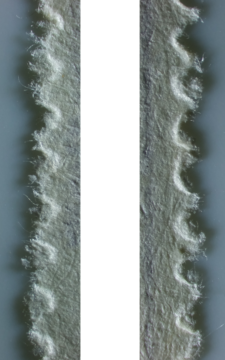 |
| Rough Perforation Upheaving |
7.4.2. Complete perforation
8. Overprints & Handstamps
8.1. Specimen Stamps
Translation of a letter from 1944 (via BUSH):
At that time, after our delivery, the Postal Administration wished that we print the wording CAMPIONE PER AFFRANCARE on a quantity of stamps, and send them to the post offices. However, at the time, it was impossible for the enormous work of our factory, the only one working in the freed Italy. Therefore, we hand printed with a special rubber stamp. "I know the rubber stamp was not only affixed to the Wolf Stamps, but also to a few examples of the rejected Badoglio stamps.
Giovanni Bader (Richter Printing)
They exist in a few known variations:
| watermarked | perforation | Bush Sheet | Example |
|---|---|---|---|
| NO | \(10 \frac{3}{4}\) | "A" | bwIDsamp003 |
| NO | \(11 \frac{1}{2}\) | "B" & "D" | bwIDsamp008 bwIDsamp005 |
| NO | \(11 \frac{1}{2}\) Rough | "C" | bwIDsamp004 |
| YES | \(11 \frac{1}{2}\) | N/A | bwIDsamp006 |
Bush Sheet: Bush sold many examples of these stamps which were removed from full sheets. They were offered in matched sets with the three unwatermarked examples all in the same sheet position. Bush labeled these singles on the back with the sheet letter and position on the plate. Bush provided Xerox photocopies of the part of the sheet from which the singles were removed. Bush never had full sheets of the watermarked variety, and thus didn't label them.
These are all pretty rare with total production quantities likely measured in the hundreds. The watermarked variety and the rough perforation variety are the hardest to find.
8.2. Postage Due
The use of the "T" handstamp was authorized in January of 1944 (See FM page 52):
Post and Telegraph Administration
1944 January 20
Circular DIREC. JAN POST 444
Ministerial Dispatch No. 400668
Subject: Taxation of Correspondence
To All Provincial Directorates
The lack of postage due is reported by various Departments. In this regard, it should be noted that this Directorate General, due to the shortage of paper and the high cost of production, cannot at the moment proceed with the reprinting of this type of values. Therefore, with immediate effect, provisions are made for the taxation of insufficiently franked correspondence to be carried out with ordinary postage stamps on which the "T" stamp must be affixed and alongside that of the date of the Office that operates the taxation. Please issue compliant orders to office employees and give assurances of execution to this Ministry.
Pertusati, Registry Director the Service
Fano, The Undersecretary of State
Note the "T" was applied to entire sheets as well as by hand stamping correspondence. Some consider these two different kinds of entities. The ones stamped as sheets being "issued stamped", and the "hand-stamped on correspondence" to be a "cancellation variety". The only examples that can be identified with 100% certainty as "hand-stamped on correspondence" are tied to a piece. Very large multiples, too large to have been on a piece, are normally considered "issued stamped". Sometimes I see examples identified based on the orientation or quality of centering of the overprint; however, this amounts to little more than a guess. In my opinion, the difficulty in distinguishing the two makes the difference mostly irrelevant – thus I won't pay a premium for material identified as one or the other…
This same "T" often appears stamped on the envelope as well as the stamps – often on the back of the cover. The stamps themselves very frequently appear as horizontal pairs. Both of my examples are watermarked and perforated \(11 \times 11 \frac{1}{2}\), but other variations exist.
8.3. REPUBBLICA
Privately overprinted REPUBBLICA in April/May of 1946 for an upcoming election (See FM page 120). I have two REPUBBLICA overprints in my collection (one in black and one in red):
8.4. Red Cross
I don't know much about this one. A picture of it exists in FM. I have one example in my collection:
9. Plate Flaws
9.1. My Plate Flaw List
WARNING: This section is very much under construction!
| PFID | Description | Position 150 | Position 168 | Examples |
|---|---|---|---|---|
| pf0001 | Broken second "A" of "ITALIANE" | 144 | 23 | bwIDsgl069 bwIDp2s005 |
| pf0002 | Gash on hind leg | 21 | 25 | bwIDp2s010 bwIDimph004 |
| pf0003 | Cloud of dots after "E" of "ITALIANE" | 30 | 34 | bwIDp2s010 |
| pf0004 | Gash in top of "C" of "CENT" | 17 19 24 27 28 30 63 65 69 70 105 122 136 145 |
28 31 32 34 60 75 77 81 125 146 162 164 |
bwIDsgl077 bwIDpf001 bwIDpdue001 bwIDp2s010 bwIDdrkw002 |
| pf0005 | Bite out of bottom of "0" of "50" | 2 24 27 28 30 63 65 69 70 95 105 122 136 138 145 |
28 31 32 34 60 75 77 81 125 146 162 164 |
bwIDsgl077 bwIDsgl073 bwIDpf001 bwIDpdue001 bwIDp2s010 |
| pf0006 | Broken tit | 11 15 24 27 28 30 31 35 51 54 56 58 63 65 69 70 71 76 78 94 97 99 100 105 111 114 119 120 122 123 126 129 136 145 |
13 17 28 31 32 34 41 60 61 64 66 68 71 75 77 81 82 85 88 90 92 107 112 115 117 118 125 133 136 146 150 153 156 162 167 |
bwIDshade004 bwIDsgl077 bwIDsgl076 bwIDsgl055 bwIDpfrk001 bwIDpf006 bwIDpf006 bwIDpf005 bwIDpf001 bwIDpdue001 bwIDp2s010 bwIDdrkw002 |
| pf0007 | Right child has birth mark on outstretched arm | 150 | bwIDshade004 bwIDsgl055 bwIDpf005 bwIDpf001 |
|
| pf0008 | Spot above "N" of "ITALIANE" | 30 | bwIDp2s010 | |
| pf0009 | Broken base | 1 36 41 44 46 48 84 57 84 89 90 101 134 150 |
1 5 49 52 54 56 84 100 103 105 106 119 121 160 |
bwIDshade011 bwIDsgl075 bwIDqbu002 bwIDqbu001 bwIDpf007 bwIDpf006 bwIDpf006 bwIDmisbg001 |
| pf0010 | Large break in "O" of "POSTE" | 86 | bwIDpf005 | |
| pf0011 | The "C" of "CENT" damaged at bottom | 34 37 38 40 73 75 79 80 105 115 125 143 |
24 35 40 43 44 46 77 83 87 89 93 94 137 144 |
bwIDsgl073 bwIDsgl070 bwIDpfrk001 bwIDpf001 |
| pf0012 | Top of "5" of "50" broken off | 34 37 38 40 73 75 79 80 105 115 125 143 |
24 35 40 43 44 46 83 87 89 93 94 137 144 161 |
bwIDsgl070 bwIDpfrk001 bwIDpf001 |
| pf0013 | Large burelage blob above "E" of "CENT." | 28 | bwIDdrkw002 | |
| pf0014 | Blob to the right of the right child | 87 | 103 | bwIDqbu002 bwIDqbu001 |
| pf0016 | Blob on top frame above first "I" of "ITALIANE" | 126 | 150 | bwIDpf001 |
| pf0017 | White shade line missing from hind leg | 159 | bwIDpf002 | |
| pf0018 | Large break in "C" of "CENT." | UNK | bwIDpf004 | |
| pf0019 | Break in frame right of "50" | 14 17 18 20 53 55 59 95 117 138 140 |
16 19 20 63 65 72 139 |
|
| pf0020 | Blob in front of front leg | 149 | 107 | |
| pf0033 | Gash at top and bottom of "C" of "RICHTER" | 1 5 41 44 46 48 84 87 89 90 101 150 |
1 5 49 52 54 103 105 106 119 121 160 |
bwIDpf007 |
| pf0034 | Large horn on "N" of "ITALIANE" | 25 | bwIDimph004 | |
| pf0035 | Blob in burelage above "0" of "50" | 83 | bwIDmisfg004 | |
| pf0036 | Dash under first tit | 19 | 21 | |
| pf0037 | Stroke of color in front of the base | 152 | bwIDp2s017 | |
| pf0038 | Claw hand left child | 114 | bwIDpfrk001 |
9.2. My Potential Plate Flaw List
WARNING: This section is very much under construction!
I only put things on the "My Plate Flaw List" if I have more than one example. In this section are potential plate flaws that may be promoted to plate flaw status if I find additional examples.
| PPFID | Description | Example | Sheet |
|---|---|---|---|
| ppf0001 | An "L" instead of "I" in "NAPOLI" | bwIDsgl070 bwIDsheetu001p144 |
168 |
| ppf0002 | Gash on front leg | bwIDsgl076 | |
| ppf0003 | Large gap in frame line at right of "50" | bwIDsgl076 | |
| ppf0004 | Dot behind hind leg below tip of tail | bwIDpf008 | |
| ppf0005 | Dot above back | bwIDpf008 | |
| ppf0006 | Snake tail on "C" of "CENT" | bwIDsheetu001p168 | 168 |
| ppf0007 | dot in "C" of "CENT" | bwIDsheetu001p161 | 168 |
| ppf0008 | in FM: Dots under the "E" of "CENT." | bwIDsheetu001p166 | 168 |
| ppf0009 | in HWW: Large horn on the "L" of "ITALIANE" | bwIDsheetu001p078 | 168 |
| ppf0010 | The "P" in "POSTE" broken at top left | bwIDsheetu001p123 | 168 |
| ppf0011 | Large blob on lower frame line and "O" of "NAPOLI" | bwIDsheetu001p131 | 168 |
| ppf0012 | Spot in front of front wolf leg | bwIDsgl053 | 168 |
| ppf0013 | Two dots behind the thigh | bwIDsheetw001p019 | 150 |
| ppf0014 | Broken "E" of "CENT." | bwIDsheetw001p117 | 150 |
| ppf0015 | Frame thin at bottom left | bwIDsheetw001p001 | 150 |
| ppf0016 | Comma shaped blob between "POSTE" and "ITALIANE" | bwIDsheetw001p041 | 150 |
| ppf0017 | Point above the "N" of "ITALIANE" | bwIDsheetw001p021 | 150 |
| ppf0018 | Horizontal dash above right edge of frame line | bwIDsheetw001p003 bwIDbh001 |
150 |
| ppf0019 | Long line of color above the box on the left | bwIDsheetw001p134 | 150 |
| ppf0020 | Thick line under base (under left child) | bwIDsheetw001p146 | 150 |
| ppf0021 | Blob below "50" | bwIDsheetw001p053 | 150 |
| ppf0022 | Point under "E" of "CENT." | bwIDsheetw001p116 | 150 |
9.3. Flaws documented in FM
| PFID | Description | Position 150 | Position 168 |
|---|---|---|---|
| Upper panel and 8 of 168 broken | UNK | 5 | |
| Point on the bottom box line. | 104 | UNK | |
| Point on the top box line | 106 | UNK | |
| Color comma at the top left outside the box | UNK | UNK | |
| Point in the right corner outside the box | UNK | 68 | |
| Point above the box line at the top | UNK | 127 | |
| Point above lower box line. | UNK | 151 | |
| pf0028 | Long line of color above the box. | 134 | UNK |
| pf0027 | Line above top box | 3 | UNK |
| Right pane line color stroke | 65 | UNK | |
| pf0024 | Frame thin print at bottom left | 1 | UNK |
| Frame line broken down | 117 | UNK | |
| pf0016 | Big dot on frame line | 126 | UNK |
| Broken square line on the left | UNK | 76 | |
| Broken frame line at bottom right | UNK | 92 | |
| Broken frame line at the top | UNK | 167 | |
| Color smear Left frame line | UNK | 127 | |
| Stroke of color in front of the base | UNK | 17 | |
| pf0037 | Stroke of color in front of the base | UNK | 152 |
| pf0029 | Color line under the base | 146 | UNK |
| Color line on the lower panel and Naples | UNK | 13 | |
| Naples partially missing. | UNK | 96 | |
| Richter Naples evanescent | UNK | 157 | |
| pf0014 | Big point between the 2nd twin and the thigh | 87 | UNK |
| Arm of the 1st twin evanescent | UNK | ||
| Big point between the 2nd Twin | UNK | 141 155 | |
| Hand of the evanescent 1 ° twin | UNK | UNK | |
| Spot of color on the thigh. | 122 | UNK | |
| pf0014 | Big stitch between the 2nd twin and the thigh | UNK | 103 |
| Point on the thigh of the she-wolf | UNK | 146 | |
| Dots in front of the knee | UNK | 107 | |
| Falla of color on the foreleg | UNK | 116 | |
| Front paw color smear | UNK | 123 | |
| Stitches under the throat | UNK | 159 | |
| Evanescent rear legs | UNK | UNK | |
| pf0020 | Big stitch in front of the paw | 149 | UNK |
| pf0021 | Two dots of color behind the thigh | 19 | UNK |
| pf0002 | Strip of color on the thigh. | 21 | UNK |
| Spot of color above the back | 29 | UNK | |
| Spot of color behind the tail. | 7 | UNK | |
| Dots under the throat of the wolf | UNK | UNK | |
| Dots under the tip of the tail. | UNK | UNK | |
| Without rear foot | NONE | UNK | |
| Strip on the thigh and stitch on the "N" | UNK | 25 | |
| pf0030 | Point below "50" | 53 | NONE |
| pf0011/12 | The "5" of "50" broken & bite out of "C" of "CENT." | 34 37 38 40 73 75 79 80 115 143 |
24 35 40 43 44 46 77 83 87 89 93 94 137 144 |
| Point up square line and point before "CENT." | NONE | 150 | |
| Broken "C" of "CENT." | UNK | 143 | |
| pf0031 | Point under "E" of "CENT." | 116 | NONE |
| pf0022 | Broken "E" of "CENT." | 117 | NONE |
| Dots under the "E" of "CENT." | NONE | 166 | |
| Broken "N" of "CENT." | NONE | UNK | |
| Point under the "T" of "CENT." | 33 | NONE | |
| Point between "CENT." and "." | 66 | NONE | |
| Point between "CENT." and "50". | 140 | NONE | |
| pf0010 | "O" of broken "POSTE" | NONE | 86 |
| Point between the "P" and "O" of "POSTE" | 147 | UNK | |
| pf0025 | Point between "POSTE" and "ITALIANE" | 41 | NONE |
| Broken "I" of "ITALIANE" | UNK | NONE | |
| Point between the "I" and "T" of "ITALIANE" | NONE | 111 | |
| Stroke on the "T" of "ITALIANE" | 98 | NONE | |
| "F" instead of "T" in "ITALIANE" | NONE | 112 | |
| Large horn on the "L" of "ITALIANE" | 66 | 78 | |
| Stroke on the "L" of "ITALIANE" | 76 | NONE | |
| Second "A" of "ITALIANE" fat center | NONE | UNK | |
| pf0001 | Broken second "A" of "ITALIANE" | 144 | 23 |
| pf0026 | Point above the "N" of "ITALIANE" | 21 | NONE |
| pf0003 | Spot after the "E" of "ITALIANE" | 30 | NONE |
9.4. Flaws documented in HWW
| PFID | Number | Description | Position 150 | Position 168 | Thumbnail |
|---|---|---|---|---|---|
| pf0009 | 1 | Break in base of wolf | 41 44 46 48 84 57 150 |
1 5 32 52 106 121 160 |
 |
| pf0019 | 2 | Broken frame right of "50" | 53 59 | 16 19 20 63 65 72 139 |
 |
| pf0001 | 3 | Broken second "A" of "ITALIANE" | 144 | 23 |  |
| pf0011/12 | 4 | The "5" of "50" broken & bite out of "C" of "CENT." | 34 37 38 40 73 75 79 80 105 115 125 143 |
24 35 40 43 44 46 77 83 87 89 93 94 137 144 |
 |
| pf0004/5 | 5 | Break "C" of "CENT." & bite out of "0" of "50" | 27 28 30 65 70 122 136 |
28 31 32 34 60 75 77 81 125 146 162 164 |
 |
| 6 | Large horn on the "L" of "ITALIANE" | 66 | 78 |  |
|
| 7 | Small horn on the "L" of "ITALIANE" | 16 | NONE |  |
|
| 8 | Horn on the "C" of "CENT" | UNK | UNK |  |
|
| 9 | Horn on shaft of "T" of "POSTE" | UNK | 103 |  |
|
| pf0010 | 10 | Broken "O" of "POSTE" | UNK | UNK |  |
10. Reference material
10.1. Literature
10.1.1. BUSH
"BUSH A.M.G. CATALOG - HANDBOOK". Edited by Harry W. Wilcke, M.D. Published by Joseph V. Bush, Inc.
10.1.2. HWW
"The AMG story: The philatelic story of the Allied Military Government in Europe at the close of World War II" by Harry W Wilcke. United States Possessions Philatelic Society (January 1, 1994). ASN: B0006F30KQ. 149 pages. Chapter 4: The AMG Bari Wolf p 43-49.
10.1.3. FM
"La lupa di Bari" by Felice Maiocchi. Studi Filatelici e Storico Postali di Firenze 1981.
10.2. Catalogs
10.2.1. Bush Catalog
10.2.1.1. Standard Entries
| Bush # | Wolf | Burelage | Watermark | Perf |
|---|---|---|---|---|
B-1 |
Lilac | Salmon | NONE | \(11\) |
B-2 |
Lilac | Salmon | NONE | \(11 \times 11 \frac{1}{2}\) |
B-3 |
Lilac | Salmon | NONE | \(11 \frac{1}{2}\) |
BUI |
Lilac | Salmon | NONE | Imperforate |
BUP |
Lilac | Salmon | NONE | Partially perforated |
B-4 |
Lilac | Salmon | HONEYCOMB | \(11 \times 11 \frac{1}{2}\) |
B-5 |
Lilac | Salmon | HONEYCOMB | \(11 \frac{1}{2}\) |
BWI |
Lilac | Salmon | HONEYCOMB | Imperforate |
BWP |
Lilac | Salmon | HONEYCOMB | Partially perforated |
10.2.1.2. Color variations
| Suffix | Wolf | Burelage | MJR Comments |
|---|---|---|---|
a |
Pale Lilac | Salmon | |
b |
Rose lilac | Salmon | |
c |
Black-brown | Salmon | "Dark Wolf" varity – common |
d |
Lilac | Black-brown | "Dark Burelage" varity – common |
e |
Black-brown | Black-brown | I have never seen one of these! |
f |
Gray-black | Salmon | I have never seen one of these! |
g |
Gray-black | Gray-black | I have never seen one of these! |
10.2.1.3. Printed one side variations
| Suffix | Wolf | Burelage | My Notation | MJR Comments |
|---|---|---|---|---|
h |
Double | Normal | dWnB |
Common |
i |
Double with Invert | Normal | zWnB |
Less Common |
j |
Normal | Missing | nW0B |
Common |
k |
Missing | Normal | 0WnB |
Common |
l |
Normal | horizontal | nWhB |
Rare |
10.2.1.4. Printed both sides Varieties
| Suffix | Description | My Notation |
|---|---|---|
m |
Wolf missing 1 side | nWnB0WnB nWdB0WnB dWdB0WnB |
n |
Burelage Missing 1 side | nWnBiW0B dW0BIWNB nWnBNW0B NWNBnW0B nWnBnW0B |
0 |
Burelage Missing both sides | nW0BnW0B dW0BnW0B |
p |
One side normal, other side with inverted wolf & missing Burelage | nWnBiW0B |
10.2.1.5. Perforation Varieties for BUP & BWP
| Suffix | Description | MJR Comments |
|---|---|---|
a |
Imperf horizontally | Common |
b |
Imperf vertically | Common |
c |
Perf 3 sides | Less Common |
d |
Perf one side | Uncommon. frequently faked |
10.2.1.6. Essays
| Bush # | Watermark | Perf | Color | Paper |
|---|---|---|---|---|
BE-1 |
VERTICAL HONEYCOMB | \(11 \frac{1}{2}\) | Violet & Gray-Brown | |
BE-2a |
VERTICAL HONEYCOMB | \(11 \frac{1}{2}\) | Violet & Gray-brown | |
BE-2 |
VERTICAL HONEYCOMB | \(11 \frac{1}{2}\) | Vermilion & Salmon | |
BE-3 |
VERTICAL HONEYCOMB | \(11 \frac{1}{2}\) | Black & Gray | |
BE-4 |
VERTICAL HONEYCOMB | \(11 \frac{1}{2}\) | Dark Blue & Light Blue-Green | |
BE-5 |
HONEYCOMB | \(11 \frac{1}{2}\) | Dark Blue | |
BE-6 |
VERTICAL HONEYCOMB | Imperforate | Violet & Gray-Brown | |
BE-7 |
VERTICAL HONEYCOMB | Imperforate | Vermilion & Salmon | |
BE-7a |
VERTICAL HONEYCOMB | Imperforate | Vermilion & Salmon | |
BE-8 |
VERTICAL HONEYCOMB | Imperforate | Black & Gray | |
BE-8a |
VERTICAL HONEYCOMB | Imperforate | Black & Gray | |
BE-9 |
VERTICAL HONEYCOMB | Imperforate | Dark Blue & Light Blue-Green | |
BE-9a |
VERTICAL HONEYCOMB | Imperforate | Dark Blue & Light Blue-Green | |
BE-10 |
VERTICAL HONEYCOMB | Imperforate | Lilac Blue & Light Violet-Brown | |
BE-11 |
NONE | \(11 \frac{1}{2}\) | Violet & Gray-Brown | Coarse tan wove |
BE-12 |
NONE | \(11 \frac{1}{2}\) | Vermilion & Salmon | Coarse tan wove |
BE-13 |
NONE | \(11 \frac{1}{2}\) | Black & Gray | Coarse tan wove |
BE-14 |
NONE | \(11 \frac{1}{2}\) | Dark Blue & Light Blue-Green | Coarse tan wove |
BE-14a |
NONE | \(11 \frac{1}{2}\) | Dark Blue & Light Blue-Green | Coarse tan wove |
BE-14 |
NONE | \(11 \frac{1}{2}\) | Vermilion & Gray | Coarse tan wove |
BE-16 |
NONE | Imperforate | Violet & Gray-Brown | Coarse tan wove |
BE-17 |
NONE | Imperforate | Vermilion & Salmon | Coarse tan wove |
BE-18 |
NONE | Imperforate | Black & Gray | Coarse tan wove |
BE-19 |
NONE | Imperforate | Dark Blue & Light Blue-Green | Coarse tan wove |
The a suffix means: no background
10.2.1.7. Specimens
| Bush # | watermarked | perforation |
|---|---|---|
CAB-1 |
YES | \(11 \frac{1}{2}\) |
CAB-2 |
NO | \(10 \frac{3}{4}\) |
CAB-3 |
NO | \(11 \frac{1}{2}\) |
CAB-4 |
NO | \(11 \frac{1}{2}\) Rough |
10.2.2. Unificato Catalogo
Based on the 2022 PDF version of the catalog. Logical pages 163-164. PDF pages 185-186.
Information listed:
- Perforations: Range from \(10 \frac{3}{4}\) to \(11 \times 11 \frac{1}{2}\)
- Printed by Richter in Napoli using an offset press.
Numbers:
- 515 Printed on 150 subject (10x15) watermarked sheets.
- 515A Printed on 168 subject (12x14) unwatermarked sheets.
Some variations
| Suffix | Text in catalog | My guess at a translation | Value |
|---|---|---|---|
| c | senza il colore del fondo di sicurezza | no burelage | 200-300 |
| d | doppia stampa | double wolf | 150 |
| e | idem, una capovolta (solo BOX) | double & inverted wolf | 250 |
| f | stampa recto-verso | printed both sides | 100-160 |
| g | fondo molto decentrato | badly centered burelage??? | 170 |
| h | BOX | imperf | 150-275 |
| j | BOX orizz. o vert. | imperf horz or vert | 100 |
| k | BOX su un lato | imperf one side | 130 |
| m | SPLIT_BOX BOX al centro | imperf between | 500-550 |
| n | dent. solo a destra o in alto | perf only on top or right | 150 |
| o | solo fondo di sicurezza (senza Lupa) | burelage only with no wolf | 250 |
10.2.3. Scott Catalog
Based on
- 2018 paper version of the catalog. Volume 3B, page 635.
- 2006 PDF version of the catalog. Volume 3, file '14_ity'. Logical page 1088, PDF page 7.
Information listed:
- Perforations: \(10 \frac{1}{2} \times 11 \frac{1}{2}\), \(11 \times 11 \frac{1}{2}\), \(11 \frac{1}{2}\), \(14\)
- Watermark: 87
- Printing method: Lithograph
- Date of issue: Jan 1944
Numbers:
- 439 Watermark: honeycomb
- 440 Watermark: None
10.2.4. Sassone
TBD

